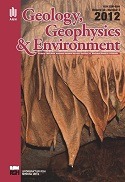Analysis and modeling of petrophysical parameters of the Main Dolomite formation on the basis of well logging and seismic data
DOI:
https://doi.org/10.7494/geol.2012.38.3.317Keywords:
the Main Dolomite, lithofacies zone, petrophysical parameters, cementation factor, Borai formula, Shell formula, fluid substitution, seismic inversionAbstract
The Main Dolomite is one of the most prospective hydrocarbon reservoir formations in Poland. The goal was to determine the Main Dolomite zonation in selected part of carbonate platform sedimentation area and also to analyze the influence of cementation factor on water saturation by well logging and seismic data integration. Well logging interpretation quantitatively characterized petrophysical parameters. Seismic inversion presented the distribution of the parameters at vertical and horizontal scales. Basic statistical calculations of petrophysical parameters, 2D crossplots and seismic inversion were made. The central part of the Main Dolomite interval indicated the best reservoir properties. High porosity values and low P-wave velocity, low bulk density and low water saturation values were observed in the analyzed zone. Mudlogging confirmed the occurrence of gas. Determination of hydrocarbon saturation in carbonates is a challenge for well logging interpretation and geophysical interpretation. The cementation factor is one of the main coefficients in petrophysics which strongly affect water saturation. Adopting the wrong value of this parameter causes serious error in the coefficient of the water saturation value. In the paper, water saturation was modeled using the Borai equation and Shell formula. By using the computed water saturation and fluid substitution method theoretical velocities of P-waves and S-waves (also P-wave/S-wave velocity ratio) were calculated. Results of the comprehensive interpretation of logs are the basis for lithology determination but P-wave and S-wave velocity can also serve as a source information about lithology. In reservoir rocks VP/VS ratio may also work as a confirmation of gas saturation.Downloads
References
Bała M., 2009. Określenie prędkości fal poprzecznych (Vs) na podstawie danych geofizyki otworowej. Przegląd Geologiczny, 57, 12, 1057-1066.
Bała M., 2008. Modelowanie wpływu zmiennego nasycenia gazem przestrzeni parowej skał na wyniki pomiarów akustycznych i innych profilowań w otworach oraz sejsmicznych pól falowych. Projekt badawczy nr 4 T12B05629, Arbor, Kraków.
Borai A.M., 1987. A New Correlation for The Cementation Factor in Low-Porosity Carbonates. SPE Formation Evaluation, December, paper SPE 14401, 495-499.
Ciechanowska M. & Zalewska J., 2004a. Wskaźnik struktury porowej skał m*. Prace Instytutu Nafty i Gazu nr 130, Geopetrol 2004, Kraków, 335-339.
Ciechanowska M. & Zalewska J., 2004b. Porównanie wskaźników struktury porowej określonych z modelu Archiego i Waxmana-Smitsa dla rdzeni wiertniczych z otworów Chałupki Dębniańskie-3 i Jesionka-4. Prace Instytutu Nafty i Gazu nr 130, Geopetrol 2004, Kraków, 819-823.
Jarzyna J., Bała M., Cichy A., Gadek W., Gasior I., Karczewski J., Marzencki K., Stadtmüller M., Twaróg W. & Zorski T., 2002. GeoWin® - System for processing and interpretation of well logging. Proceedings of the 8th Conference and Exhibition of EEGS-European Section, Aveiro, Portugal, September 8-12 [CD only].
Jaworowski K. & Mikołajewski Z., 2007. Oil- and gas-bearing sediments of the Main Dolomite (Ca2) in the Międzychód region: a depositional model and the problem of the boundary between the second and third depositional sequences in the Polish Zechstein Basin. Przegląd Geologiczny, 55, 12/1, 1017-1024.
Kotarba M. & Wagner R., 2007. Generation potential of the Zechstein Main Dolomite (Ca2) carbonates in the Gorzów Wielkopolski-Międzychód-Lubiatów area: geological and geochemical approach to microbial-algal source rock. Przegląd Geologiczny, 55, 12/1, 1025-1036.
Krakowska P. & Niepsuj M., 2010. Influence of cementation factor on water saturation in carbonates of Main Dolomite in north-west Poland. 72nd EAGE Conference and Exhibition incorporating SPE EUROPEC 2010 in Barcelona, Extendes Abstracts, Publications Base Earth Doc EAGE, on-line: www.eage.org.
Krakowska P., 2009. Dobór parametrów petrofizycznych węglanowych skal zbiornikowych w celu podwyższenia dokładności wyznaczenia współczynika nasycenia wodą. Biblioteka Wydziału Geologii, Geofizyki i Ochrony Środowiska AGH, Kraków [Ms.C. Thesis].
Landmark, 2009. Landmark Graphics Corporation International Strategic University Grant Agreement, No. 2009-UGP-008037, GeoGraphix Help.
Niepsuj M., 2009. Sejsmika 3D kluczem do precyzyjnego odwzorowania budowy strukturalno-tektonicznej platform Chartowa oraz do określenia właściwości potencjalnych skał zbiornikowych. Biblioteka Wydziału Geologii, Geofizyki i Ochrony Środowiska AGH, Kraków [Ms.C. Thesis].
Niepsuj M. & Krakowska P., 2011. Analysis of the Main Dolomite Ca2 zonation in the NW part of Polish Lowlands using integrated seismic methods and well logging data. 73rd EAGE Conference and Exhibition incorporating SPE EUROPEC 2011 in Vienna, Conference materials, Publications Base Earth Doc EAGE, on-line: www.eage.org.
Pikulski L., 2004. Analiza paleogeograficzna utworów dolomitu głównego (Ca2) w rejonie Lubiatów-Międzychód-Grotów w aspekcie poszukiwania złóż. Nafta-Gaz, 60, 9, 397-405.
Solarski T., 2010. Porównanie porowatości utworów dolomitu głównego wyznaczonych przy pomocy różnych metod inwersji sejsmicznej. Prace Instytutu Nafty i Gazu nr 170, Geopetrol 2010, Kraków, 503-507.
Veritas DGC Inc., 2004. Hampson Russell Guide.
Wagner R., Dyjaczyński B., Papiernik B., Peryt T.M. & Protas A., 2000. Mapa paleogeograficzna dolomitu głównego (Ca2) w Polsce. In: Kotarba M.J. (red.), Bilans i potencjał węglowodorowy dolomitu głównego basenu permskiego Polski, Archiwum WGGiOŚ AGH, Kraków.
Downloads
Published
Issue
Section
License
Authors have full copyright and property rights to their work. Their copyrights to store the work, duplicate it in printing (as well as in the form of a digital CD recording), to make it available in the digital form, on the Internet and putting into circulation multiplied copies of the work worldwide are unlimited.
The content of the journal is freely available according to the Creative Commons License Attribution 4.0 International (CC BY 4.0)










